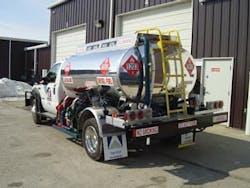By Dyke Chapman, corporate development director, Ascent Aviation Group Inc.
Electronic GSE fueling systems can correct inefficiencies and prevent errors on the ramp.
Five years ago at Aviation Industry Expo, I was approached by one of our customers with an interesting challenge. At that time the price of ground fuel had spiked and had shown up on the radar screen as a significant cost of their operations. Airlines and service providers began addressing rising costs of each facet of their respective operations harder than before and GSE fuel, largely ignored in the past, became a priority.
We began to analyze the problem and discovered that, for the most part, GSE fueling was performed manually, which included: identification of the type of fuel, recording the owner of the equipment, and recording the fuel dispensed. There were concerns pertaining to several issues: accurate accounting of fuel dispensed, dispensing the wrong product in a piece of equipment, and theft. In a perfect world, a fueler would identify each piece of equipment requiring fuel and know the customer and product type used. The fueler would record this information on a clip board or tally sheet, repeating for each transaction until their shift was over. This information would then have to be manually entered into a back office data processing system for both reconciliation and billing. Quite often the information was difficult to read and was recorded incorrectly.
We identified many inefficiencies and opportunities for error:
- During the fueling process it was always possible to dispense the wrong fuel in the wrong equipment because there was no safeguard to prevent it from happening
- Depending on weather conditions, the degree of accuracy would vary greatly. If it was raining, snowing, windy or just plain cold, a driver may fuel several pieces of equipment and record them after the fact, relying on memory
- Getting the tally sheet wet, either from fuel or precipitation, could make it difficult to read by the time it reached the operations office
- When it came time to total the deliveries, the driver penmanship could easily cause mistakes to be made while trying to interpret the information
It became quickly apparent that to solve all of these issues, there needed to be an electronic solution that would automatically identify each piece of GSE requiring fuel, eliminate the requirement to record the data manually, control the internal valves to prevent misfuels, and provide the information in a format that can be imported into a back office data processing system.
Ascent Aviation Group decided to develop a solution and it was important to align with a partner that shared a similar vision and provided additional capabilities. We defined a system with three major priorities:
- Eliminate the responsibility of collecting, recording, or posting data,
- Prevent misfueling
- Make it robust enough and easy to use when performing under the harsh environment of airport ramps in all weather conditions
We partnered with Liquid Controls to develop this new system and for the next five years we collaborated on FleetConnect.
FleetConnect is a GSE management system for fleet fueling operations, fulfilling the initial requirements we identified early on. The system is mounted on a GSE Rampservicer that provides mobile refueling on the airfield. It can be mounted to older equipment with minor modifications or be provided from the factory on a new truck. FleetConnect provides accurate accounting of GSE fueling without requiring the fueler to record or enter any data, transmits the data electronically, and won’t let the fueler put the wrong product in the wrong equipment. The benefits from FleetConnect go far beyond the original challenges. No more lost tickets, unreadable tickets, transposition errors, misfuelings, or unaccounted fuel. The ramp operations become efficient and the time required to fuel a large pool of equipment is greatly reduced. These were expected improvements, but it has evolved into a fleet management tool as well. The information collected identifies equipment that hasn’t received fuel over an extended period of time, raising questions as to whether it is needed at all or could be utilized at another location. Preventative maintenance on GSE fleets can be scheduled using burn rate and consumption, eliminating either premature or postponed maintenance.
We have come to understand that each company must reinvent themselves, constantly providing forward thinking and try to create the solutions to questions that haven’t been asked yet.




